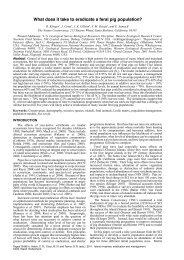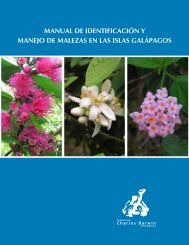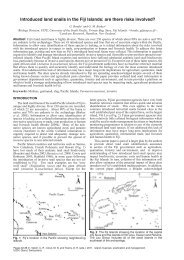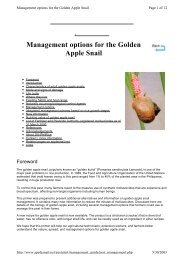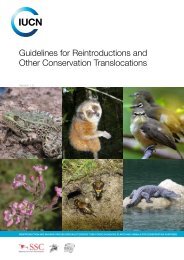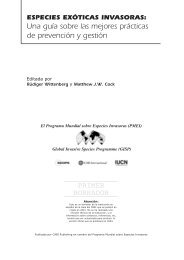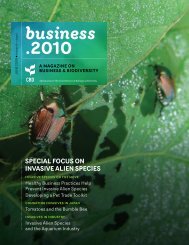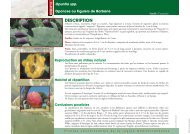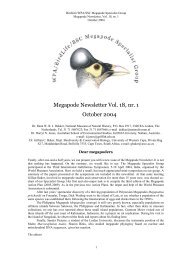Aliens Newsletter - ISSG
Aliens Newsletter - ISSG
Aliens Newsletter - ISSG
Create successful ePaper yourself
Turn your PDF publications into a flip-book with our unique Google optimized e-Paper software.
Most importantly, the proposed guidelines were then<br />
reviewed by the IUCN team and prepared as an official<br />
publication of the year-long process and this<br />
was placed on the IUCN website in early 2010<br />
(IUCN, 2009b). The guidelines were then officially<br />
launched in hard copy at the WINROCK India<br />
meeting on biofuels on 12 th February, 2010.<br />
In this way the process was able to provide guidance<br />
for each stage which is described in detail in<br />
the published document. A summary of these guidelines<br />
for each of the 4 steps follows:<br />
1. Planning: Stakeholders involved in the production<br />
of biofuels from introduced plant feedstocks<br />
should conduct a cost-benefit analysis that includes<br />
the potential costs of a consequent invasion. Governments<br />
should develop strategic environmental<br />
assessments to plan biofuel production at national<br />
level while developers and investors should conduct<br />
environmental impact assessments at project level<br />
that would include weed risk assessments of the<br />
species concerned. These plans should be underpinned<br />
by contingency funds set aside as insurance<br />
for any necessary remedial actions in the future as<br />
well as a commitment from the outset to be vigilant<br />
to the possibility of a biological invasion, and willingness<br />
to take measures to prevent its spread from<br />
the production system.<br />
2. Importation: Importation of feedstocks and their<br />
plant propagules should occur within a suitably robust<br />
quarantine system which needs to be prepared<br />
to inspect and approve/prevent unwanted or unlicensed<br />
species. Governments should strengthen<br />
their capacity to monitor and enforce phytosanitary<br />
regulations and base polices on feedstock imports<br />
on sound ecological policies. Developers and investors<br />
should comply with all national regulations<br />
relating to the importation of live plants or their<br />
propagules. This includes the possible introduction<br />
of pests and diseases associated with the feedstocks.<br />
3. Production: Feedstock plantations should only be<br />
developed subject to the preparation, submission<br />
The Guidelines<br />
The guidelines (resulting from the steps described<br />
above) are based around the four identified stages<br />
along the supply chain of biofuel production from<br />
plantations of introduced plants which were described<br />
throughout the workshops and guidelines as:<br />
and implementation of an Environmental Management<br />
Plan (EMP). Such plans should include:<br />
• Detailed best practices to be followed<br />
• A contingency strategy to manage a possible “escape”<br />
of a biofuel plant species or a pest or disease<br />
organism that could become invasive<br />
• Provision of a contingency fund to support eradication,<br />
containment, management or restoration<br />
• Preparation and implementation modalities for a<br />
monitoring system to check for feedstock “escapes”<br />
and the presence of pests or pathogens emanating<br />
from the biofuel plantation.<br />
EMPs should be audited by a neutral third party with<br />
the relevant expertise.<br />
4. Transportation/Processing: Risks of invasion related<br />
to transport and processing of feedstocks<br />
should be minimized by reducing the distances that<br />
viable plants and propagules are moved; meanwhile,<br />
conversion of feedstocks should occur on-site of the<br />
plantation if possible. Governments and developers<br />
should ensure adequate monitoring of transport vehicles<br />
for the presence of seeds, feedstock plant remnants<br />
and pests. All stakeholders should promote<br />
awareness of the risks associated with biological invasions<br />
and the need for vigilance in ensuring that<br />
introduced plants do not initiate invasions and that<br />
there is a robust monitoring system to detect any<br />
signs of invasions – particularly in susceptible habitats.<br />
Five key recommendations: In addition to the main<br />
guidelines, the publication describes five practical<br />
key recommendations for biofuel producers and<br />
processors using introduced plants as feedstocks.<br />
<strong>Aliens</strong> 27



